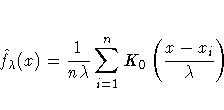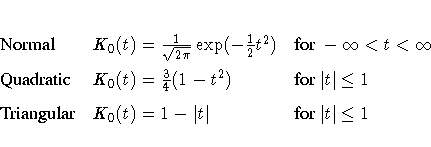Kernel Density Estimates
You can use the KERNEL option
to superimpose kernel density estimates on histograms.
Smoothing the data distribution with a kernel density estimate
can be more effective than using a histogram
to examine features that might be
obscured by the choice of histogram bins or sampling
variation.
A kernel density estimate can also be more
effective than a parametric curve fit when the
process distribution is multimodal.
See Example 4.5.
The general form of the kernel density estimator is

where K0(·) is a kernel function,  is the
bandwidth, n is the sample size, and xi is the i th
observation.
is the
bandwidth, n is the sample size, and xi is the i th
observation.
The KERNEL option provides three kernel functions
(K0): normal, quadratic, and triangular. You can specify
the function with the K= kernel-option in parentheses
after the KERNEL option.
Values for the K= option are
NORMAL, QUADRATIC, and TRIANGULAR (with aliases of N, Q, and T,
respectively).
By default, a normal kernel is used.
The formulas for the kernel functions are

The value of  , referred to as the bandwidth parameter,
determines the degree of smoothness in the estimated
density function. You specify
, referred to as the bandwidth parameter,
determines the degree of smoothness in the estimated
density function. You specify  indirectly by specifying a standardized bandwidth c
with the C= kernel-option. If Q is the
interquartile range, and n is the sample size, then
c is related to
indirectly by specifying a standardized bandwidth c
with the C= kernel-option. If Q is the
interquartile range, and n is the sample size, then
c is related to  by the formula
by the formula

For a specific kernel function, the discrepancy between the
density estimator
 and the true density f(x) is measured
by the mean integrated square error (MISE):
and the true density f(x) is measured
by the mean integrated square error (MISE):

The MISE is the sum of the integrated squared bias and the
variance. An approximate mean integrated square error (AMISE) is

A bandwidth that minimizes AMISE can be derived by
treating f(x) as the normal density having parameters
 and
and  estimated by the sample mean and
standard deviation. If you do not specify a bandwidth
parameter or if you specify C=MISE, the bandwidth that
minimizes AMISE is used. The value of AMISE can be
used to compare different density estimates. For each
estimate, the bandwidth parameter c, the kernel function
type, and the value of AMISE are reported in the SAS log.
estimated by the sample mean and
standard deviation. If you do not specify a bandwidth
parameter or if you specify C=MISE, the bandwidth that
minimizes AMISE is used. The value of AMISE can be
used to compare different density estimates. For each
estimate, the bandwidth parameter c, the kernel function
type, and the value of AMISE are reported in the SAS log.
Copyright © 1999 by SAS Institute Inc., Cary, NC, USA. All rights reserved.

![]() is the
bandwidth, n is the sample size, and xi is the i th
observation.
is the
bandwidth, n is the sample size, and xi is the i th
observation.



